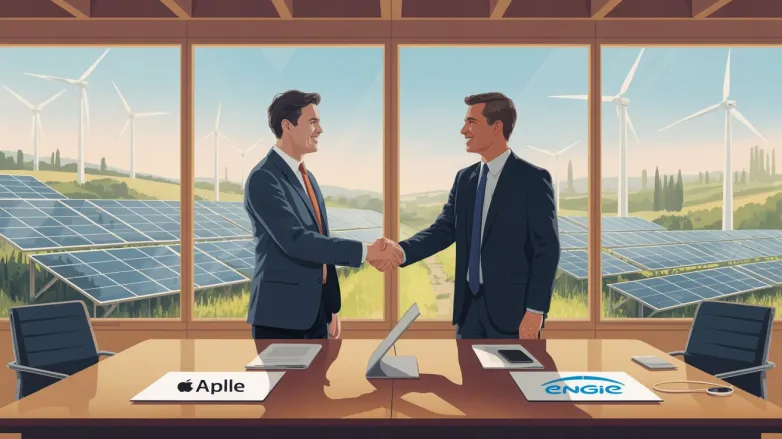Apple, Engie Sign 10-Year Italian Clean Power Deal
Oct 27, 2025 09:30 AM ET
- Apple inks 10-year Engie deal for 173 MW of new Italian wind and solar, powering regional operations, stabilizing costs, and accelerating Europe-wide supply-chain decarbonization.

Apple (NASDAQ: AAPL) signed a 10-year power purchase agreement with Engie (EPA: ENGI) to source electricity from 173 MW of new wind and solar projects in Italy. Engie will build and operate the capacity, delivering power to the Italian grid to support Apple’s regional energy needs. Financial terms and project timelines were not disclosed.
The deal advances Apple’s renewable energy strategy and supply-chain decarbonization efforts in Europe while expanding Engie’s Italian renewables portfolio. Corporate PPAs like this provide long-term price certainty and add new clean capacity to the grid, bolstering Italy’s energy transition and helping Apple hedge against power-market volatility.
How will pricing, additionality, and certificate handling work in Apple–Engie Italy PPA?
- Pricing structure: most likely a virtual (financial) PPA settled against Italy’s PUN or zonal price, with Apple paying a fixed strike and receiving/paying the difference to market price; alternatives include pay‑as‑produced fixed price or fixed‑for‑floating swap with a collar.
- Shape and cannibalization: price may include a shaping premium to account for wind/solar profile versus Apple’s load; caps/floors or collars can limit exposure to low mid‑day solar prices and high evening ramps.
- Indexation: fixed price could be partially indexed to inflation (e.g., Italian CPI) or O&M indices; some deals use flat pricing with periodic step‑ups.
- Volume basis: settlement likely “as‑generated” (per metered MWh) rather than baseload; a cap on annual settled volume and make‑whole provisions are common to manage over/under‑production.
- Curtailment and availability: pricing typically distinguishes grid/market curtailment (often seller risk) vs. buyer‑requested curtailment (buyer risk); availability guarantees may trigger liquidated damages rather than price changes.
- Balancing and imbalance: Engie, as generator, generally bears forecasting and imbalance risk; Apple’s financial exposure is to market‑price differences, not physical balancing.
- Credit and tenor effects: 10‑year term supports bankability; fixed price likely reflects counterparty credit (parent guarantee/LC) and Italy country/market risk premia.
- Regulatory change: price reopeners or pass‑throughs may apply for material changes in Italian taxes, levies, congestion rules, or GO schemes.
- Additionality: projects are new‑build capacity in Italy dedicated to the PPA; Apple’s offtake underwrites financing, making the build “additional” versus buying unbundled certificates from existing plants.
- Grid‑region alignment: locating generation in Italy aligns with country‑level additionality and proximity claims often required by corporate reporting frameworks.
- Temporal matching: baseline is annual MWh matching; Apple may pursue enhanced monthly or hourly matching to advance 24/7 goals, using project metering and settlement data.
- Certificate type: Guarantees of Origin (GO) issued under the EU EECS scheme; Italy’s GSE issues GOs per verified MWh.
- GO transfer and retirement: Engie transfers GOs to Apple (or its designated account) monthly/quarterly; Apple retires them in the EECS registry to claim renewable consumption and avoid double counting.
- Scope 2 accounting: retired GOs support market‑based Scope 2 reporting under the GHG Protocol; disclosures list plant IDs, technology, country, and vintage.
- Excess attributes: if output exceeds contracted volumes, contract may allow Apple first right to additional GOs at formula pricing; otherwise Engie can sell surplus GOs to market.
- Claim integrity: Apple will avoid reselling retired GOs and match claims to the same period and geography as electricity use, aligning with RE100/CSRD expectations.
Also read


